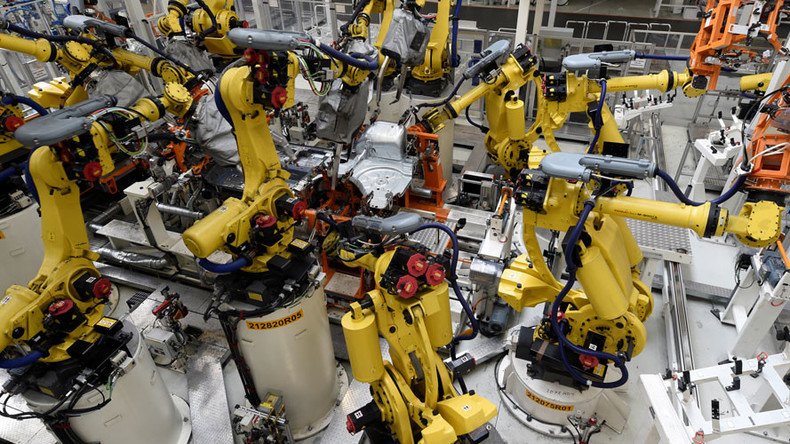Robot workers replace ‘blue collar’ workers, not managers – study

Blue collar workers are most at risk from robots according to a new study which claimed six jobs are lost for every one robot introduced per 1,000 employees. Managerial roles saw little or no change.
The study published this month by economists Daron Acemoglu and Pascual Restrepo from the National Bureau of Economic Research aims to put facts and figures in place of the myths surrounding the robot workforce, examining if the defense that it creates as many jobs as it destroys was credible.
Stephen #Hawking calls for ‘world government’ to stop robot apocalypse https://t.co/RMl2GgU2uJpic.twitter.com/1O39VN7CLL
— RT (@RT_com) March 9, 2017
“We estimate large and robust negative effects of robots on employment and wages across commuting zones,” the study, which examined US employment between 1990 and 2007, said. In such commuting zones between three and 5.6 jobs were lost for every one robot introduced per 1,000 employees, with wages seeing a decline of between 0.25 and 0.5 percent.
Allowing for variables, including the offshoring of roles and the impact of imports, the study used the International Organization for Standardization’s definition of an “industrial robot” for the study. This required the robot to be automatically controlled and programmable for multi-purpose tasks, as well as being able to move in three or more axes.
Draft giving legal status to #robots & categorizing them as ‘electronic persons’ endorsed by EU committee https://t.co/B4MAhPhuXI#AI#robotpic.twitter.com/sashSzN3pq
— RT (@RT_com) January 12, 2017
Under the definition robots like those used on a car assembly line were included, but a computer or a simple one-axis machine, such as a conveyor belt, were not.
“We see negative effects of robots on essentially all occupations, with the exception of managers for which we estimate a zero effect in our baseline specification,” the study found.
“Predictably, the major categories experiencing substantial declines are routine manual occupations, blue-collar workers, operators and assembly workers, and machinists and transport workers.”
'Sweating’ lets robot do 11 minutes of push-ups without frying motors https://t.co/aKPNyqTHE7pic.twitter.com/zuD1VOxkFd
— RT (@RT_com) October 15, 2016
The study warned the effect so far has been limited on jobs, which they claim have seen a decrease of between 360,000 and 670,000 during the period as a result of the introduction of robots. They warned in the next two decades the effects could be “much more sizeable” with the predicted expansion of a robot workforce.
The findings come in stark contrast to US Treasury Secretary Steve Mnuchin’s words last week that AI replacing human jobs was not on his “radar screen.” Speaking to Axios he claimed the issue was “50-100 more years away.”
"I'm not worried at all. In fact, I’m optimistic," Mnuchin said.
In Britain, robo-bricklayers are due to arrive on building sites over the coming months. The robots require a human to set them up before they can pick up bricks, apply mortar and lay them. The news came after PricewaterhouseCoopers claimed up to 10 million jobs are at risk in the UK over the next 15 years as a result of robots.












